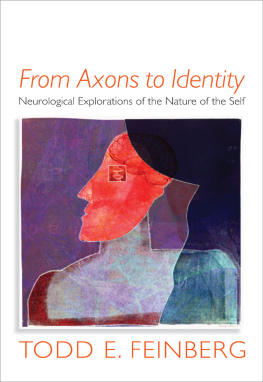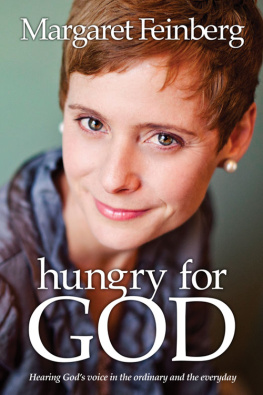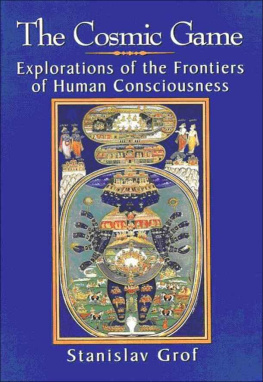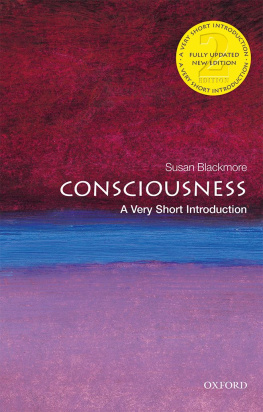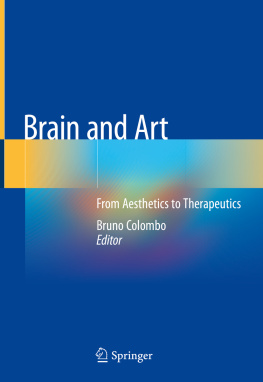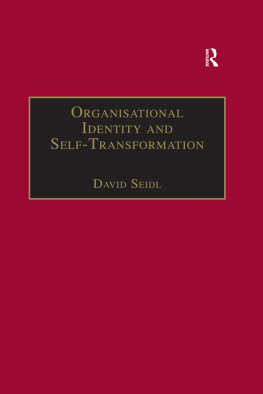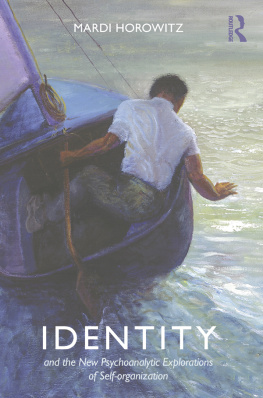FROM AXONS TO IDENTITY
Neurological Explorations of the Nature of the Self
TODD E.FEINBERG, M.D.

Copyright 2009 by Todd E. Feinberg, M.D.
All rights reserved
For information about permission to reproduce selections from this book, write to Permissions, W. W. Norton & Company, Inc., 500 Fifth Avenue, New York, NY 10110
Library of Congress Cataloging-in-Publication Data
Feinberg, Todd E.
From axons to identity: neurological explorations of the nature of the self / Todd E. Feinberg. 1st ed.
p. cm. (The Norton series on interpersonal neurobiology)
Includes bibliographical references and index.
ISBN: 978-0-393-07294-5
1. Identity (Psychology) 2. Self. 3. Personality disorders. 4. Neuropsychology. I. Title.
BF697.F443 2009
155.2dc22 2008052428
W. W. Norton & Company, Inc., 500 Fifth Avenue, New York, N.Y. 10110
www.wwnorton.com
W.W. Norton & Company Ltd., Castle House, 75/76 Wells Street, London W1T 3QT
ACKNOWLEDGMENTS
T HIS BOOK is the product of many years of thought and writing. In my career in clinical work and research it has been my privilege to work with and learn from so many brilliant people, too many to name. Some in particular are Kenneth Heilman, who was my first teacher in behavioral neurology, and the late Dr. Edwin Weinstein, who first introduced me to the possibilities of integrating neurological concepts with dynamic-defensive operations. For this particular book, I had wonderfully instructive e-mail correspondence with several researchers and theoreticians who generously shared with me their insights in their respective fields, including Tim Allen, Bud Craig, Derek Denton, Phoebe Cramer, Michael Lewis, Tom Mandel, Bjorn Merker, Rudolf Nieuwenhuys, Georg Northoff, Stanley Salthe, Allan Schore, Mark Solms, and Marjorie Taylor. Marsel Mesulam was an invaluable resource, particularly on the neuroanatomical issues, and Dr. David Roane has been a frequent collaborator in my clinical research over the years. I owe all these wonderful explorers a great debt, but of course the opinions expressed here and whatever mistakes I have made are my own. A special thanks is owed to Jill K. Gregory, MFA, CMI who provided the beautiful illustrations, and Marilyn Rivera and Michael Rothman for manuscript assistance.
Grants from the Gerald J. and Dorothy R. Friedman New York Foundation for Medical Research have been instrumental in supporting our clinical and research programs. A special thanks is owed to Betty Yarmon and her late husband, Mort, and Jane Friedman, all of whom have been, and continue to be, immensely supportive of our Center. I also wish the thank my wonderful agent and steadfast supporter Deirdre Mullane, whose sharp literary eye and insights were so helpful in shaping this work, and my exceptional editor at W. W. Norton, Deborah Malmud, who guided this project from its inception and made working on it more pleasure than work. And finally, once again, my mom Gloria and dad Mort, my wife Marlene, and kids Rachel and Josh, for helping me grow my self.
INTRODUCTION
From Axons to Identity
I F I ASK YOU , Who are you? chances are you will tell me your name. But if I ask you to tell me more about yourself, to explain who you think yourself to be, how you view your personal identity in a broader sense, then I can expect a range of answers. Some people identify themselves by their careers, others by their place in a family, some by their ethnicity or country, others by their religion. And if I ask you, What are you doing right now? there is no single correct answer. You might say you are sitting in a chair, waiting for dinner, preparing for a lecture, or reading this book. And if I ask you, Where are you at this very moment? your answer might range from your kitchen to your home to your city. My point is that there is enormous leeway in how we view ourselves, a viewpoint that can change from moment to moment, and is to a large extent dependent upon who is asking the questions and for what reasons. It is also very much related to what a person wants to express about him-or herself.
Although it may seem clear what we mean when we refer to ourselves, in fact the status of the self as an object of study is a matter of considerable controversy. There are nearly as many conceptions of the self, or what is sometimes referred to as a sense of self, as there are writers on the subject. One reason for this continuing debate is that how one views the nature of the self will depend upon ones particular intellectual background and approach. Whether the adopted perspective is grounded in philosophy, religion, literature, psychology, sociology, or neuroscienceto name a few of the common approacheswill influence ones speculations on the nature of the self. Indeed, the ideas generated from these diverse viewpoints are often unrelated or mutually incompatible.
The philosopher Galen Strawson, who has written extensively on the subject, describes these multiple perspectives on the nature of the self:
It is difficult to know where to begin, because there are many different notions of the self. Among those I have recently come across are the cognitive self, the conceptual self, the contextualized self, the core self, the dialogic self, the ecological self, the embodied self, the emergent self, the empirical self, the existential self, the extended self, the fictional self, the full-grown self, the interpersonal self, the material self, the narrative self, the philosophical self, the physical self, the private self, the representational self, the rock bottom essential self, the semiotic self, the social self, the transparent self, and the verbal self.
In one recent bit of extraordinary academic sleuthing, the psychologists Mark Leary and June Tangney identified sixty-six different terms to refer to some aspect of identity or the self.
In the face of these many ways of thinking about the self, one further question that immediately comes to mind is whether and how one might distinguish the idea of consciousness from the concept of the self. This problem is made all the more complex because there are as many meanings of the word consciousness as there are definitions of the self. I believe the succinct definition provided by the philosopher John Searle to be sufficient: Consciousness consists of inner, qualitative, subjective states and processes of sentience or awareness. By almost any criteria, a definition of the self will require that for there to be a self, there must also be consciousness, in order for that self to come into being and continue to exist. But certainly the idea of the self goes beyond simple awareness, as the many forms of the self described above make clear.
When the self is considered from the standpoint of neuroscience, one primary concern is how awareness is integrated and organized into a coherent whole, since that whole is what is emphasized when we refer to the self or the mind. Here the emphasis is not upon any single momentary act of perception or motor response, but rather upon the totality of the brains functions into unified experience and action. Indeed, one major reason why the self seems so difficult to explain on a purely neurobiological basis is that, while we experience a unified consciousness, there appears to be an essential difference between the unified mind and the divisible brain. We know the nervous system is composed of millions of neurons grouped into numerous larger structures. The question is, how do all of these physically connected but materially separable structures function as the seamless whole that we experience as our unified selves? In this volume the problems of the unity of the self and the unity of mental phenomena in general will be considered as essentially the same problem with the same solutions, and these aspects of the problem of the self will be one of our primary interests.

